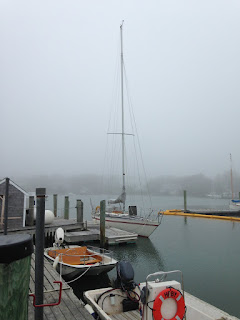Refit after seven years not a refit of seven years' duration. Two years was long enough!
To start, the back story. We sailed to the Cape in May of 2014, moored in Stage Harbor and hardly used the boat for a dozen hours that season. Family visitors (many), a new house to settle into, grandma to care for and so on. Averisera was hauled and placed in dry storage. During dry storage, we undertook to refit the boat. As with every project of that nature, the mission crept upwards in complexity, time, and money. Then, one day, it was over. We launched.

Above: The rewards of the refit: a sail. Everything works. The sky is blue. The sea is blue. Nantucket Sound was magical. October, 2016. Just over two years after we hauled out for a long dry storage term and refit.

7 December 2016, Averisera at her Winter berth in Harwichport, MA

9 May, 2014, Averisera, having just arrived from Boston. We tied up at the boatyard in Harwichport for the night with no idea we'd be back two years later.

September 2014: Hauled and washed before being trailered to the inland storage facility of Harwichport Boat Yard. The longest sail of the season was from Stage Harbor to Wychmere Harbor.

September 2016: Back in the water, Very shiney and new looking. She floats higher without all the old bottom paint and five years of accumulated cruising/racing gear.
One of the big jobs that came with much uncertainty was painting the deck. The decking is charcoal grey TreadMaster. We could find nothing about painting TreadMaster and a couple of painters were not encouraging. We spoke with one paint company representative at a boat show about it. He couldn't say one way or the other. We tried it and are satisfied so far. A sample place was tested and lasted four years. We painted the decking with Pettitt Platinum. Time will tell.


Two views of the deck before and after. The motivation was that the dark deck was simply too hot in summer. The first coat was splotchy so two coats of enamel were applied. The TreadMaster is a superb surface for not slipping when wet. Painted, it loses a bit of traction and is still better than most non-skid decks I have used. Next time... ha... I will prime the surface with white primer and finish with an enamel+non-skid mix. (https://www.treadmaster.co.uk/)
Inside is where most of the hard work took place.





Some images of the interior refit. The headliner "mousefur" was removed and new carpet-like surface applied. The inside of the hull was painted and the wood painted or varnished. The "mouse fur" was odious stuff to remove. Many successive layers of paint remover were applied and scraped off. Eventually, we romved all the deck hardware and got the job done right. Plan A was to paint the overhead. Plan B was a much better solution. The fabric is from Sail Rite.
Thumper and the Boom-Boom Room:


Off-plan: the Thumper the Engine needed to be removed and rebuilt. While out, the Boom Boom Room (engine space) was cleaned, re-soundproofed and painted.

On plan, the instrument holes in the bulkhead were filled, faired and painted.
 On plan and forgotten. The standing rigging fits into reinforced inserts. Those pieces are all cracked. We knew about it before we rigged and simply forgot to do the replacement of the reinforcements. When the rigging crew was all lined up and ready to step the rig, it was too late. We will unstep the mast, make the repair and re-step the rig as soon as possible. What was it Astro said? "Rhut rho Rhorge." A simple fix to make and stupid thing to forget.
On plan and forgotten. The standing rigging fits into reinforced inserts. Those pieces are all cracked. We knew about it before we rigged and simply forgot to do the replacement of the reinforcements. When the rigging crew was all lined up and ready to step the rig, it was too late. We will unstep the mast, make the repair and re-step the rig as soon as possible. What was it Astro said? "Rhut rho Rhorge." A simple fix to make and stupid thing to forget.We love our boat so trading her in on a newer model was out of the question. We looked at few boats and figured that the cost in time and money favored Averisera.


































